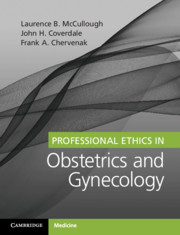Book contents
- Professional Ethics in Obstetrics and Gynecology
- Professional Ethics in Obstetrics and Gynecology
- Copyright page
- Dedication
- Contents
- Preface
- Acknowledgments
- Section 1 Professional Ethics in Obstetrics and Gynecology
- Section 2 Pedagogy of Professional Ethics in Obstetrics and Gynecology
- Section 3 Professionally Responsible Clinical Practice
- Section 4 Professionally Responsible Leadership
- Section 5 Professionally Responsible Innovation and Research
- Chapter 17 Clinical Innovation and Research in Obstetrics and Gynecology
- Section 6 Professionally Responsible Health Policy and Advocacy
- Glossary of Key Concepts
- Index
- References
Chapter 17 - Clinical Innovation and Research in Obstetrics and Gynecology
from Section 5 - Professionally Responsible Innovation and Research
Published online by Cambridge University Press: 01 November 2019
- Professional Ethics in Obstetrics and Gynecology
- Professional Ethics in Obstetrics and Gynecology
- Copyright page
- Dedication
- Contents
- Preface
- Acknowledgments
- Section 1 Professional Ethics in Obstetrics and Gynecology
- Section 2 Pedagogy of Professional Ethics in Obstetrics and Gynecology
- Section 3 Professionally Responsible Clinical Practice
- Section 4 Professionally Responsible Leadership
- Section 5 Professionally Responsible Innovation and Research
- Chapter 17 Clinical Innovation and Research in Obstetrics and Gynecology
- Section 6 Professionally Responsible Health Policy and Advocacy
- Glossary of Key Concepts
- Index
- References
Summary
This chapter provides an ethical framework to guide clinical innovation and research in obstetrics and gynecology.
Improving the quality of obstetric and gynecologic care depends on clinical innovation and research. Innovation and research are both experimentation. An experiment occurs when in deliberative clinical judgment the outcomes of a clinical intervention cannot be reliably predicted.
- Type
- Chapter
- Information
- Professional Ethics in Obstetrics and Gynecology , pp. 201 - 214Publisher: Cambridge University PressPrint publication year: 2019



